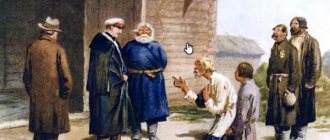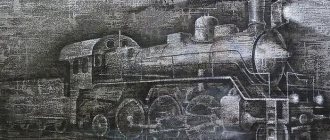A few words about Ermolai
The narrator went into the forest to hunt woodcock. He took with him an experienced hunter named Ermolai, who belonged to a landowner, so to speak, of the old style. The man had:
- thin build;
- a big increase;
- grey eyes;
- narrow forehead;
- a long nose;
- wide lips.
He looked to be about 45 years old. He always wore blue trousers and a German-cut caftan. The owner abandoned the hunter because he believed that he was not suitable for any work. Ermolai had only one duty: once a month to supply the master’s kitchen with black grouse and partridges.
Being as carefree as a bird, the man often got into various troubles, but he always managed to return home unharmed with a gun and a dog. He never fed his dog Valetka; he considered her an intelligent creature who was quite capable of getting food on her own.
It was difficult to call him the soul of the company, but still he loved to chat and was always in a great mood. The hunter had a wife. His wife lived in a dilapidated house and suffered hardships. Ermolai visited her no more than once a week, and behaved rather rudely. The tyrant never stayed with his wife for more than a day. He was real only with her, those around him did not even suspect this trait of his and knew him as a completely adequate, albeit slightly eccentric Yermolka.
Meeting with Arina
The men went hunting in a birch grove on the bank of Ista. It was already dark, and they decided to spend the night at the mill, but the owner refused to let them in. They took straw from the miller and lay down on the street, hiding under a canopy. The hostess brought potatoes. While the hunter baked it in the ash, the narrator fell asleep. He was awakened by quiet whispering. He raised his head and noticed the girl. It was clear from her face that she used to be very beautiful. It turned out that this was the miller's wife Arina. She spoke quietly to the hunter. He invited her to visit him and promised to drive his wife away.
The narrator decided to talk to her. He learned that she had previously worked as a maid for the wife of Count Zverkov. The hunter knew this man; he occupied a very important place. It was from this man that he heard Arin’s story. Zverkov's wife was angry, fat and suspicious. She didn't want to keep married maids. Arina served with her for 10 years, and then began to ask permission to get married. She received a harsh refusal. After some time, it became clear that the girl was expecting a child. The count ordered her to be taken to the village. The footman Petrushka, from whom she became pregnant, was sent to serve as a soldier.
Ermolai said that Arina’s baby did not survive. She had already been the wife of a miller for 2 years, who bought her from the master. The man was flattered by her intelligence and beauty.
Plot and composition of the story
The story is one of a whole list of hunting stories. Having gone hunting with Ermolai, the author stops for the night at a mill. There, from a conversation between the miller's wife and the hunter, he heard about the fate of the girl Arina. While still a little girl, she was taken from her parents in St. Petersburg and sent to serve the landowner. She was not married to her beloved, since maids cannot be married.
When the lady found out about her relationship with the footman Petrushka, the girl was sent to the village, and her beloved was sent to serve as a soldier. At the new place, the local miller liked Arina, who bought her and married her.
Compositionally, the story consists of two halves, as if one plot represents two different passages. The main story is about the spring hunt and a description of the overnight stay. There, the author describes the life of a wandering hunter. In the second part, Arina’s story is presented to the readers’ attention. The plot is united by pictures and descriptions of spring nature, inherent in central Russia.
Analysis and history of the creation of the work
Turgenev loved to write philosophical works “from nature” so that the reader would have the opportunity to independently think out the plot . In them, he often showed that ordinary peasants are characterized by high morality, and these simple people are capable of beautiful and sublime impulses.
The story of Ermolai tells of the nobility of an ordinary miller. With a story about Arina’s life, the author makes it clear that she cannot agree to the hunter’s offer to stay instead of his wife. However, the reader must reach this point himself, because the work does not contain 100% factual conclusions.
Some characters have prototypes. For example, Zverkova's maid appeared under the influence of a real story . In 1839, V.P. Turgeneva sold the girl to Akulin along with her little daughter because the courtyard girl dared to get pregnant. The prototype of the hunter Ermolai is the huntsman Alifanov, who served under Turgenev. In 1835 they went hunting together.
The story tells about the plight of the serfs, whose lives were entirely dependent on their owners. In Arina and her beloved, the landowners saw only servants, but not living people. It was because of this that their lives went awry. Fortunately, the girl was lucky; her beautiful appearance did not go unnoticed, and she managed to marry another man.
Being a realist writer, Turgenev wanted to show the life of ordinary peasants as it is. Those facts that amaze the reader are perceived by the characters themselves quite naturally and habitually.
The work has the features of an essay and claims to be documentary. It also contains signs of a story, this was noticed by readers of Sovremennik. Let’s say that in the retrospective parts of “Yermolai and the Miller’s Woman” the entire lives of the characters pass.
History of creation
The entire cycle of “Notes of a Hunter” was conceived back in 1842, when Turgenev expressed a desire to write several comments “about the Russian economy and the Russian peasant.” The story “Yermolai and the Miller’s Wife” was written in 1847, the second after the story “Khor and Kalinich”, and published with three more stories in the cycle in the magazine “Sovremennik” No. 5.
Some heroes of the story have prototypes. Thus, the maid of the landowner Zverkova arose under the influence of a true story: V.P. Turgeneva sold the courtyard girl Akulina along with her newborn daughter in 1839 for what the worker dared to “bring into the world.”
The prototype of Ermolai is Afanasy Alifanov, who served as a huntsman for Turgenev. He hunted with Turgenev from 1835.
Issues, plot and composition
In his work, the author examines such a problem as the human dignity of the serf and his fate, which depends on the mood of the owner. Today, reading this story, one can be amazed at the lack of rights of a girl who is first taken away from her father and mother to another city, and then made a maid and forbidden to marry, after which she is forced to agree to become the wife of a man to whom she is indifferent. At the same time, she should thank fate for such changes in fate.
The author, willy-nilly, highlights the problem of serf women, who had even fewer rights than the men who belonged to the landowners.
When the owner finds out that Arina is expecting a child from Petrushka, he does not blame the guy. Simply because it is his decision.
Compositionally, the work is a story within a story, first the author talks about Ermolai, and then conveys the story to the serf. The harsh spring nature of the middle zone serves as a backdrop to everything that happens.
Literary genre and issues
Turgenev's goal as a realistic writer is to show the life of ordinary peasants with all the nuances of its manifestation. Many details of the story that the characters consider ordinary and normal strike the modern reader to the core.
An analysis of the story “Yermolai and the Miller’s Wife” allows us to understand that this essay can even be classified as documentary. But the work also contains features of a story, as well as pictures describing the journey. And, of course, scenes from the lives of the heroes are shown here. So the story can be classified as a multifaceted work.
The main problem raised by the author in the story is the description of how the human dignity of serfs is trampled upon by landowners . For modern people, it is completely unacceptable that a woman can be sold to another family, married off without her consent, taken away from her loved one and her life completely ruined. Moreover, the meaning of the story is that the girl should thank her masters for everything done for her good. Thus, Turgenev involuntarily raises the problem of the complete lack of rights of serf women. They have even fewer rights than male serfs.
The landowners themselves are often representatives of high society and even support those who talk about the need for reforms in relations with peasants.
But in fact, they consider their serfs to be ungrateful people who do not understand the prosperity provided to them.
Main characters
Characterizing his heroes, Turgenev describes their portraits, characters, and habits. Ermolai dresses colorfully and uses an old, uncomfortable gun.
To show how unhealthy the relationship between a serf and his master can be, the author introduces a hero such as the dog Valetka . Ermolai does not give her food, believing that the animal can find food for itself. The dog does not leave, but on occasion he feasts on the hare shot by Ermolai. The owner does not give the serf gunpowder, but gives him almost absolute freedom, which is to the liking of the hunter.
Ermolai is always in motion, sometimes his movements are absurd. He visits his wife once a week, showing no concern for the woman. Among strangers, the man is considered an eccentric; they call him Yermolka. From the outside he seems like an inattentive person, but in reality this is not at all the case.
A hunter knows how to see what is most important. Let's say he immediately asks Arina how she is feeling, and she really is suffering from an unbearable cough. Ermolai does not allow the narrator to be distracted from the most important thing - hunting.
The man recognizes Arina as the miller's wife. She is a 30-year-old girl with a pale and thin face. Her big sad eyes are still beautiful.
Arina's wife calls Ermolai a fat belly. He looks terrible, he has:
- huge belly;
- bull's nape;
- fat face.
During a conversation with the hunter, Arina is balanced and calm. She has some similarities with Valetka. For example, she is characterized by the same disappointment and “incomprehensible indifference to everything in the world.” She gave birth to a stillborn baby. However, the hunter speaks about this as if in passing, as if it were something natural.
Each of the main characters of “Yermolai and the Miller’s Woman” perceives Arina’s dangerous illness, which makes her feel worse and worse. The landowners are not the key figures in the work. All that is said about Ermolai’s owner is that he abandoned his serf as a man unfit for any work. At the same time, he himself did not care about him at all.
Landowner Zverkov
As for Count Zverkov, he is described in more detail. It was not by chance that the author chose such a surname for this hero. After all, he really is a beast at his core, even though he tries to seem kind. His plump wife is exactly the same.
The reader is amazed that for Zverkov and his wife, serfs are ordinary slaves who must please the master in everything and thank him for everything. The landowner is outraged that the courtyard girl was not ashamed to upset the lady and upset her master. He believes that serfs are devoid of heart and feelings.
Zverkov is inclined not to finish his sentences, as if the interlocutor himself must think out the truisms. In fact, during Turgenev’s time there were many such landowners. They considered themselves good-natured, preaching liberal values and showing unimaginable cruelty.
The author characterizes his characters in detail and comprehensively, their tragic life becomes visible precisely in a stop, in a conversation, in a reasoning.








